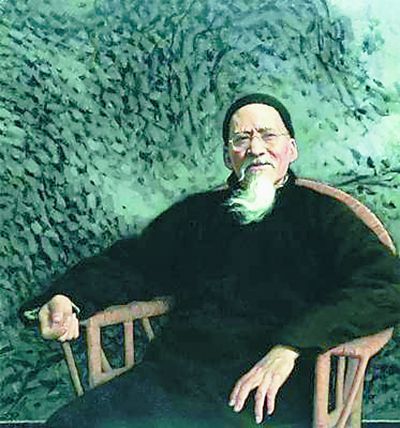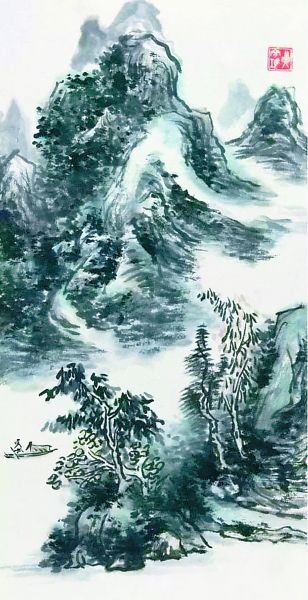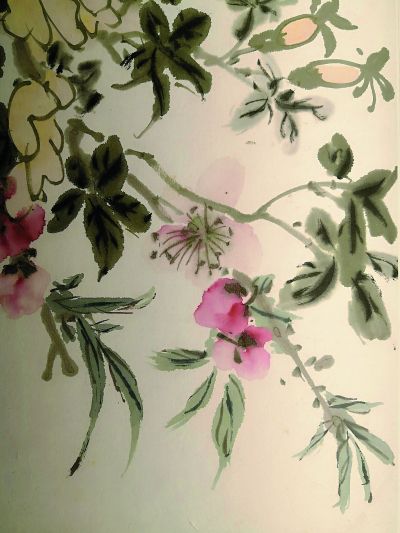Original title: Yinyun Pinbin Hong

Huang Binhong Jin Shangyi

▲ Huang Binhong's landscape and flowers

Dense Changhong Huang Binhong Painting and Calligraphy Exhibition
Venue: Lecture Hall of Beijing Lu Xun Museum
Time: September 28 to November 28, 2018
In late autumn, Beijing feels cool, but the museums are bustling. When people flocked to the Tsinghua Art Museum to see the "500 Year Exhibition of Western Painting", more than 100 important calligraphy and painting works of Huang Binhong were quietly displayed in the lecture hall just opened as an exhibition hall on the west side of the Lu Xun Museum compound in Beijing.
Neimei
Huang Binhong was not known by ordinary people when he died in 1955, but he predicted that his paintings would surely attract the attention of the world 50 years later. In fact, less than 50 years ago, his works have attracted people's attention both in professional research institutions and in auctions. What made Huang Binhong brilliant? What kept him in obscurity for a long time? The answer should start from the source.
Huang Binhong, whose ancestral home is Anhui, was born in Zhejiang and buried at the foot of the green mountain beside the West Lake. In his youth, he actively participated in the national salvation movement of political reform. After failing, he fled to the homeland of Chinese traditional culture, pondered and combed the evolution path of traditional painting, took inheriting the essence of national painting as his own responsibility, and finally forged mountains, vegetation, and flowers into writing, The spirit of "inner beauty" of Chinese art, which he pursued and advocated all his life, is fully presented.
A painting should give the viewer a unique inner feeling. The essence of Chinese painting is the matter of spirit, the externalization of thoughts and feelings, the accumulation of cultural cultivation, and the concentration of a person's life character. This is where Huang Binhong's artistic achievements lie. His landscape is dominated by the accumulation of ink. In a painting, there are thick, light, dry, wet, light and heavy. Only by watching it repeatedly can we feel its richness. As Shi Tao, one of the "Four Monks" in the early Qing Dynasty, said, the spirit is brilliant and comes from the paper. Qi Baishi's paintings are suitable for both young and old. Few people say they can't understand them, because the interest expressed in his works is closer to life. However, Huang Binhong's exploration of painting theory through pen and ink is too profound, and only by entering his ideological world can he understand something. Qi Baishi's paintings are popular and clear, while Huang Binhong pursues elegance and implication.
The meeting of mind and environment is for the dense
Huang Binhong's mountains have veins, and water has a source. He emphasized the technique of writing and paid more attention to the use of ink. He especially emphasized that the relationship between the hidden and the exposed should be handled well.
As the ancients said, "Those who are good at hiding may not hide, and those who are good at revealing may not belong to those who do not hide." Tibet and dew are dialectical unity. The essence of concealment and exposure embodies the concept of emptiness and reality in Chinese painting. The ancients said, "Everything without a picture is a wonderful place." The existence and absence of each other, and the reality and emptiness of each other, express the Chinese Tai Chi culture. The ink in the painting is black, and the place not painted is white. Black and white are the atmosphere of Tai Chi. In the continuous transformation of emptiness and reality, the weather is life. We can understand "Qi" as "Qi of life". Huang Binhong's painting is not big, but it makes you feel that the small shows the big, and the ordinary shows the strange. Few paintings mean a lot. In fact, this is a very unique part of Chinese painting.
This exhibition gathers Huang Binhong's early, middle and late works. In his early years, he observed nature carefully and recorded what he saw at any time, leaving behind a large number of works called "Ji You", which had a strong sense of sketching. Along with his reading, his research on culture has become more and more intensive. Since his youth, he has been committed to the pursuit of "the most gorgeous is plain". In his later years, he has finally reached the realm of "no image and no form", and his pen and ink are free to follow his subjective thoughts. From the works in this exhibition, we can see that his paintings, regardless of size, did not deliberately carve parts or stick to the use of a certain stroke of ink, but tried to pursue the overall image expression.
Meaning, the meaning of a painter, is the expression of his subjective externalization. The realm is the realm of the painter, which is the subjective choice in the face of the objective, thus forming his own world. Meaning and conception form artistic conception, that is, the unity of subjective and objective is reached, which is the perfect combination of nature and affinity. The meaning and the environment are integrated into the feelings and scenery, and are standardized by the painting theory. The ancients often said: "The combination of meaning and environment is for dense."
With vigor and elegance
A painter can create a subjective world with his pen and ink. This does not mean that Huang Binhong's landscapes and flowers are separated from nature and life. He always has something to rely on. Never fabricate a school of landscape illusion on paper. From the evolution of his paintings, we can see the clear context of his learning from the ancients. The most common ones in his works are either his painting experience or the summary of his experience in ancient times. He never goes to extremes and is seldom impatient. He always pursues the integration of the mountains and rivers described with his own ideas. Huang Binhong's paintings truly reflect the taste of Chinese culture and are thought-provoking.
At the age of 90, Huang Binhong has made further progress in landscape painting and has entered the realm of transformation. His flower paintings like to use color waterlogging and ink breaking. Writing and inking, the flow of blunt and elegant air flows in the end. It really achieved the sentence "with vigor and grace", which is often mentioned in his paintings. This exhibition is divided into three units: flowers and birds, landscape and calligraphy. It aims to show Huang Binhong's works and art, and highlight the immortal contribution of the creation of Chinese paintings and calligraphy achievements to the history of modern Chinese art.
As a painter of the old era, Huang Binhong dared to face the impact of Western paintings, the decline of literati paintings, and the dilemma of traditional Chinese values. He stuck to the position of local culture, and found a huge driving force beyond the limitations of the times from the source of traditional culture and art. The mountains and rivers described by Huang Binhong are no longer limited to specific forms, but the pursuit of ink style. The so-called "deep and rich" is the same as the painters of the Ming and Qing Dynasties, especially the "four kings" of the early Qing Dynasty. In his life, Huang Binhong has almost seen the ink of famous painters in all dynasties, and has infiltrated the styles of various painting schools. Therefore, it can be said that although there is a distance between the east and the west, and there is a time dimension between the Ming and Qing Dynasties and modern times, the two Chinese painting exhibitions, which were staged in different places, are the best echoes of their artistic tastes and evolution paths.
(Text: Wang Jiannan)
(Editor in charge: Lu Jing, Yuan Bo)
Share to let more people see

































